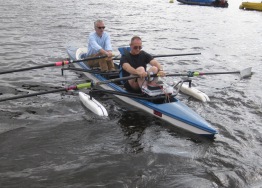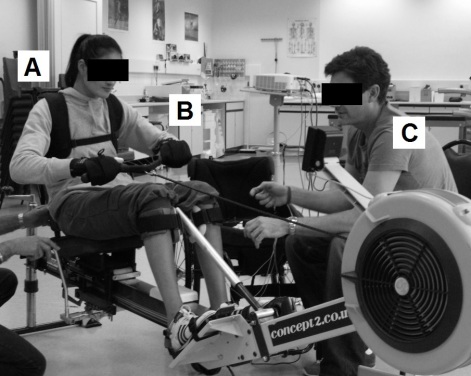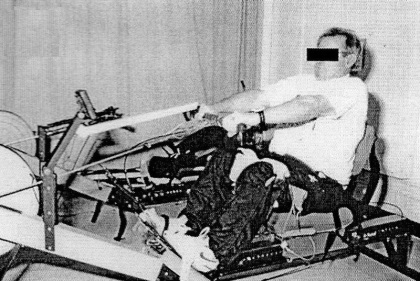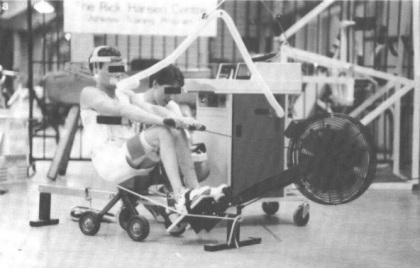Cardiovascular Disease Interventions
This section presents the most recent scientific studies that have primarily used an FES intervention to mitigate cardiovascular disease following SCI.
The articles are presented under the year of publication, newest first in descending date order. Each post includes the study title, contributing authors, the journal the article was published in, and a précis of the study or review findings.
2014: FES-rowing in tetraplegia: a preliminary report
Gibbons RS, Shave RE, Gall A, Andrews BJ. FES-rowing in tetraplegia: a preliminary report. Spinal Cord 2014 Dec; 52(12): 880-886.
Female with a complete C4 SCI during a 30-min FES rowing training session
Study Findings
This study, the first of three with tetraplegia as the primary theme, was designed to assess the feasibility of FES rowing in tetraplegia. Eight individuals with complete and incomplete injuries ranging from C4 to C7 successfully participated in the 12-month study. With some modifications to the equipment, all participants were able to continuously row for 30-minutes three times per week after completing 13 ± 7 FES rowing training sessions. Peak and steady-state power outputs all increased over the 12-months.
2002: Functional electrical stimulation-assisted rowing: Increasing cardiovascular fitness through functional Electrical Stimulation rowing in persons with spinal cord injury
Wheeler GD, Andrews BA, Lederer R, Davoodi R, Natho K, WEiss C, Keon J, Bhambhani Y, Steadward RD. Functional electrical stimulation-assisted rowing: Increasing cardiovascular fitness through functional Electrical Stimulation rowing in persons with spinal cord injury. Archives of Physical and Medical Rehabilitation 2002; 83: 1093-1099.
ROWSTIM II a development of Laskin’s FES-rower
Study Findings
This prototype, ROWSTIM II, enabled training volumes of up to 30 minutes at a time necessitating the development of training protocols. Like ROWSTIM I, this system used 4-channels to stimulate components of the quadriceps and hamstring muscle groups. Target exercise volume was three 30-minute rows per week with an exercise intensity of 75% - 80% of a pre-determined peak oxygen uptake test.
1993: Electrical stimulated-assisted rowing exercise in spinal cord injured people: a pilot study
Laskin JJ, Ashley EA, Olenik LM, Burnham R, Cumming DC, Steadward RD, Wheeler GD. Electrical stimulated-assisted rowing exercise in spinal cord injured people. A pilot study. Paraplegia 1993; 31: 534-541.
Laskin’s innovative rowing prototype ROWSTIM
Study Findings
This innovative new exercise device, ROWSTIM 1, was developed to investigate the potential health benefits of an exercise modality that combines concurrent voluntary upper limb exercise with FES assisted lower limb exercise in people with SCI. ROWSTIM 1 was conceptualised by Dr Garry Wheeler. The device was based on a 4-channel FES system that enabled components of the quadriceps and hamstring muscle groups to be stimulated via their respective peripheral nerves. Inevitably this first-of-a-kind prototype had a number of design limitations which restricted training to a few minutes at a time. However, it did demonstrate its future potential with design modifications. A new prototype was developed in 2002 called ROWSTIM II.
Three exercise modalities where compared, FES leg-only rowing, arms-only rowing and FES rowing. The primary metrics used to compare the exercise modalities were relative oxygen consumption (V̇O2·kg) and heart rate. FES rowing produced mean (± SE) steady state values of 16.34 ± 0.74 mL·kg-1·min-1 which represented 83% of the peak FES rowing values achieved, or 23% increase over arms-only rowing, or 118% over FES leg-only rowing. Steady state heart rates were 105 bpm for FES rowing compared to 112 bpm when arms-only rowing, or 71 bpm when FES leg-only rowing.
Although the prototype developed in this study had a number of design limitations, the results highlighted the potential health benefits FES rowing might offer including reduced risk factors for cardiovascular disease and improved quality of life.
Return to Scientific Articles








